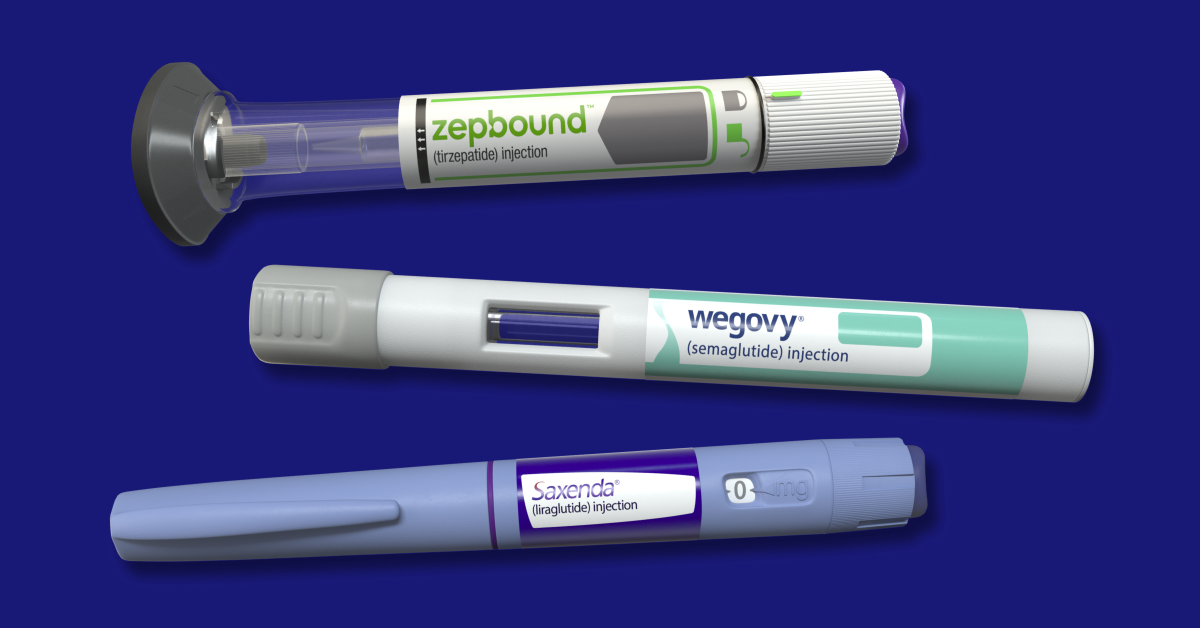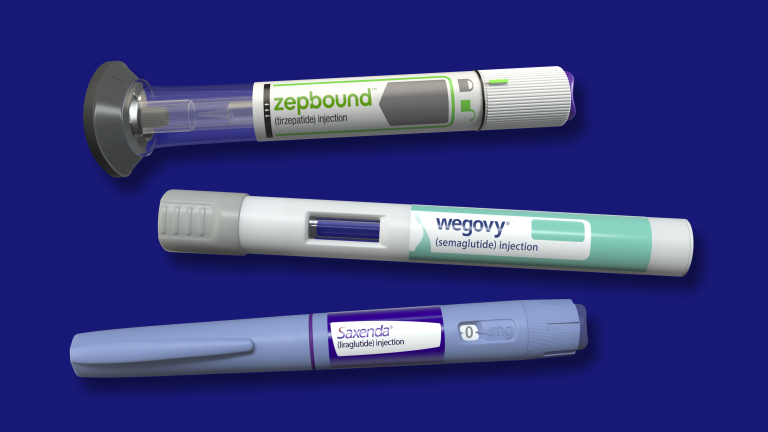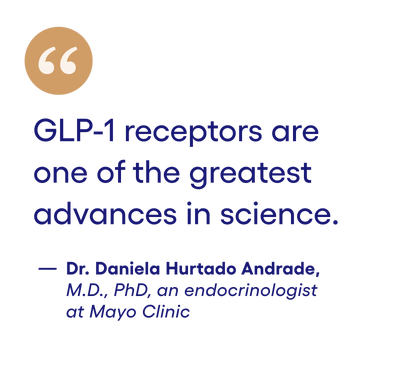The health benefits of GLP-1s


It’s easy to miss the full story of GLP-1s. The reputation they tend to have—as a brand new medication that is solely used for weight loss—is far from the whole picture. For one thing, they’ve actually been around for two decades. And for another, weight loss wasn’t even their first known benefit.
In 2005, the first GLP-1 got FDA approval to manage type 2 diabetes due to its ability to keep blood sugar stable, with others soon following. But a side effect quickly stole the spotlight: People taking GLP-1s started losing significant amounts of weight and keeping it off. So in 2014, the FDA began approving these medications for weight loss—first Saxenda (liraglutide), then Wegovy (semaglutide), and most recently Zepbound (tirzepatide).
And new research is making it become apparent that when it comes to health benefits, blood sugar and weight are just the beginning. “GLP-1 receptors are one of the greatest advances in science, including medical science,” says Dr. Daniela Hurtado Andrade, M.D., PhD, an endocrinologist at Mayo Clinic. “They’re groundbreaking because they have a multi-organ effect.” In other words, because there are GLP-1 receptors throughout the body, their benefits can extend far as well. The full impact that GLP-1s can have on your health are still being understood, but here’s what we know so far.
How do GLP-1 medications work?
GLP-1s, or glucagon-like peptide-1 receptor agonists, are a class of medications that interact with receptors in the gut and brain. While GLP-1 is a naturally occurring hormone in the body (its main purpose is to help stimulate the release of insulin after you eat), it doesn’t last very long—only a few minutes. GLP-1 medications, on the other hand, stick around in your body much longer. And this extended stay is what leads to the health benefits.
For now, almost all GLP-1s are administered through daily or weekly injections (the pill forms get digested by the gut and have a much smaller impact in the body). But that could change within the next five years, says Dr. Mark Seeley, M.D., PhD, director of Michigan Diabetes Research & Training Center. “Injections are easiest for GLP-1s to enter the bloodstream as small proteins, but companies are working to create a more efficient pill form. In most cases, it will make GLP-1s much cheaper and easier to access.”


How GLP-1s help manage type 2 diabetes
GLP-1s were first approved by the FDA for this exact reason: to manage type 2 diabetes by lowering blood sugar levels to a more normal fasting range and by improving insulin sensitivity. They do this by dialing up how much insulin your body produces and lowering the production of glucagon, a hormone that elevates blood sugar levels. That one-two punch promotes stable blood sugar levels. Medications approved for this use include Mounjaro (tirzepatide), Ozempic (semaglutide), and Victoza (liraglutide).
An area of ongoing research is the cascading effect taking a GLP-1 can have on the body. Having controlled glucose levels can help prevent severe complications from type 2 diabetes like kidney disease, retinal diseases, neuropathy (losing feeling in the hands and feet), and development of non-healing wounds in the feet, and experts are now looking into whether GLP-1s reduce the risk for those complications.
One thing that is becoming clear is that GLP-1s can help prevent prediabetes from progressing into the full-fledged disease. Researchers followed people who had prediabetes and overweight or obesity for three years. Those who took tirzepatide weekly reduced their risk of developing type 2 diabetes by 94 percent compared to those who didn't take the medication.
GLP-1 agonists and appetite
Of all the FDA-approved medications for weight management, GLP-1s have gotten the most buzz due to the amount of weight you can lose. The three medications currently approved by the FDA for this purpose are Zepbound (tirzepatide), Wegovy (semaglutide), and Saxenda (liraglutide). People taking semaglutide can lose on average 15 percent or more of their weight while a clinical trial found that one-third of participants on tirzepatide lost 25 percent of their weight over 72 weeks.
A main way GLP-1s lead to weight loss is by slowing down the rate at which food leaves the stomach, making you feel fuller for longer and less hungry throughout the day. GLP-1s also affect the hypothalamus in the brain, which further reduces hunger—even when losing weight. This is a huge shift from how the body normally reacts to weight loss. “We have brain mechanisms that naturally want to prevent caloric restriction,” says Hurtado Andrade. “GLP-1s change those behaviors and deactivate those mechanisms.” Perhaps most significant for those who have struggled with regaining weight, studies have shown that GLP-1s also help you maintain weight loss as long as you continue taking them.
How to amplify the weight-loss benefits when taking a GLP-1
It’s important to note that in weight-loss studies, GLP-1 agonists were paired with lifestyle changes, such as diet and exercise. Prioritizing nutrient-dense foods and moving your body more are important to improving your long-term health when taking a GLP-1. You don’t need to do it alone, though. The new WeightWatchers GLP-1 Companion Program is designed to help you learn key habits, such as eating more fruits and vegetables, staying hydrated, getting enough protein, and strength training at least twice a week. The goal: to improve your weight health, which is the degree to which your weight impacts your mental and physical well-being, and create habits that will help you prevent disease and feel your best for years to come.
The impact of GLP-1s on food noise
One common refrain from people who take GLP-1s: They think less about food—like what they want to eat next and when they’re going to eat it. More research is needed to understand why GLP-1s appear to reduce food noise, but it could be due to the reduced appetite and how the medications signal to the brain, which could help you focus less on hunger and eating throughout the day. But another reason for the quieter food noise may be because GLP-1s affect the reward center of the brain, so you don’t get as much pleasure from eating certain foods. (That post-cake euphoria isn’t as strong.) “GLP-1s override the hedonic component of the brain’s reward system—that part of the brain that wants us to eat food for the sole purpose of consuming something we like,” says Hurtado Andrade.
Heart and kidney health and GLP-1s
The reason that medical experts recommend weight loss to certain people in the first place is because having overweight or obesity is linked to a higher risk for serious health issues. That led researchers to a big question: Will losing weight with a GLP-1 help lower those risks? A large international clinical trial, SELECT, has shown that when it comes to your heart health, the answer is yes.
The research found that taking semaglutide reduces the risk of major cardiovascular events, such as stroke, by as much as 20 percent. “The SELECT cardiovascular trial shut down a year early because results were so impressive,” says Seeley. The exact mechanisms are still being studied, but researchers believe the impact on heart health might be because GLP-1s help reduce blood pressure, inflammation, and cholesterol.
Looking more closely at people living with diabetes, a recent meta analysis of 11 randomized controlled trials found that GLP-1s significantly reduced both cardiovascular and kidney events (such as kidney failure). Further, a clinical trial of over 3,000 people living with type 2 diabetes and chronic kidney disease found that semaglutide led to improvement for kidney, cardiovascular, and survival outcomes — including a 24% reduced risk of kidney disease events, 18% lower risk of major cardiovascular events. What’s more, it resulted in a 20% lower risk of death — from any cause.
Research like this is why, in January 2025, the FDA approved Ozempic — the brand name version of semaglutide for type 2 diabetes — to reduce the risk of complications in people who have both type 2 diabetes and kidney disease.
Do GLP-1 agonists boost mood and memory?
The gut and brain are closely linked, and GLP-1s can affect both. Research shows that GLP-1s circulate in the blood to the brain, where they help control the secretion of certain neurotransmitters and affect inflammation. The result: reduced risk for depression and improved recall in some people. This is still a relatively new area of research, with more studies needed to understand exactly what’s going on.
How can GLP-1s reduce addictive behaviors?
Because GLP-1s impact the parts of the brain involved with reward, researchers began to wonder if they could reduce addictive behaviors. Animal studies show that GLP-1s reduce cocaine, amphetamine, nicotine, and alcohol use. A recent study of 14,053 WeightWatchers found that nearly half of people who drink had reduced their alcohol use after starting a GLP-1.
“A significant number of my patients [on GLP-1s] are no longer drinking,” says Hurtado Andrade. “They just don’t want it anymore. And patients who have had alcohol use disorders now have their drinking under complete control. As we go forward, it will be very, very important to study how these medications can affect other diseases.”
GLP-1s and sleep apnea
Like diet and exercise, sleep is critical for weight loss. But if you’re living with overweight or obesity, you’re more likely to miss out on proper rest due to obstructive sleep apnea. Excess weight can increase pressure on your upper airways — and this can stop you from breathing for short periods of time during sleep.
“The prevalence of obstructive sleep apnea (OSA) is significantly higher in individuals with obesity,” says Dr. Jamil Alkhaddo, M.D., medical director at WeightWatchers. “In [one] trial, 80% of participants with obesity had some form of it.” Since weight loss can reduce sleep apnea symptoms, it makes sense that GLP-1s could mitigate them as well.
In December 2024, the FDA gave Zepbound (tirzepatide) an additional approval to treat obstructive sleep apnea. In clinical research, Zepbound was five times more effective than placebo in reducing breathing disruptions in adults not on PAP machines. And in adults on PAP therapy, Zepbound led to 29 fewer breathing disruptions per hour (compared to six with placebo).
This is important, notes Alkhaddo, because sleep apnea is far more than snoring. “It’s associated with long-term complications including hypertension, stroke, heart failure, and impaired quality of life. It’s also linked to metabolic disorders such as diabetes, and has been associated with depression and potentially cancer.”
The bottom line
GLP-1s were first FDA-approved for managing type 2 diabetes and obesity, but research is showing that they might have much wider reaching health benefits. In addition to reducing weight and lowering blood sugar, they can also help improve cardiovascular and kidney health, quiet food noise, reduce your risk for depression, treat sleep apnea, and possibly minimize addictive behaviors. It’s an area of active research, with studies being done to support these initial benefits and reveal new ones.
This content is for informational purposes only and does not constitute medical advice, diagnosis or treatment. It should not be regarded as a substitute for guidance from your healthcare provider.
WeightWatchers relies on only the most trustworthy sources, including highly credentialed experts, government and academic institutions, peer-reviewed studies, and respected medical associations. We focus on primary sources and research that is recent, relevant, and high-quality. For more about how we report, write, and fact check our stories, please see our editorial policy.
FDA-approved GLP-1s: StatPearls (2023). “Glucagon-Like Peptide-1 Receptor Agonists.” https://www.ncbi.nlm.nih.gov/books/NBK551568/
Tirzepatide: The Lancet (2023). “Tirzepatide once weekly for the treatment of obesity in people with type 2 diabetes (SURMOUND-2): a double-blind, randomised, multicentre, placebo-controlled, phase 3 trial.” https://www.thelancet.com/journals/lancet/article/PIIS0140-6736(23)01200-X/fulltext
Extending the feeling of fullness: Diabetes Spectrum (2017). “Glucagon-Like Peptide 1 Receptor Agonists for Type 2 Diabetes.” https://www.ncbi.nlm.nih.gov/pmc/articles/PMC5556578/
Stabilizing blood sugar levels: Postgrad Medicine (2015). “User’s Guide to Mechanism of Action and Clinical Use of GLP-1 Receptor Agonists.” https://pubmed.ncbi.nlm.nih.gov/26371721/
Preventing type 2 diabetes: Lilly Investors (2024). "Tirzepatide reduced the risk of developing type 2 diabetes by 94$ in adults with pre-diabetes and obesity or overweight." https://investor.lilly.com/news-releases/news-release-details/tirzepatide-reduced-risk-developing-type-2-diabetes-94-adults
Liraglutide weight loss: The New England Journal of Medicine (2015). “A Randomized, Controlled Trial of 3.0 mg of Liraglutide in Weight Management.” https://www.nejm.org/doi/full/10.1056/nejmoa1411892
Semaglutide weight loss: The New England Journal of Medicine (2021) “Once-Weekly Semaglutide in Adults with Overweight or Obesity.” https://www.nejm.org/doi/full/10.1056/NEJMoa2032183
Tirzepatide weight loss: The New England Journal of Medicine (2022). “Tirzepatide Once Weekly for the Treatment of Obesity.” https://www.nejm.org/doi/full/10.1056/NEJMoa2206038
Maintaining weight loss: JAMA (2021). “Effect of Continued Weekly Subcutaneous Semaglutide vs Placebo on Weight Loss Maintenance in Adults with Overweight or Obesity.” https://www.ncbi.nlm.nih.gov/pmc/articles/PMC7988425/
Fewer cravings: Diabetes, Metabolic Syndrome and Obesity (2023). “The Efficacy of GLP-1 Analogues on Appetite Parameters, Gastric Emptying, Food Preference and Taste Among Adults with Obesity: Systematic Review of Randomized Controlled Trials.” https://www.ncbi.nlm.nih.gov/pmc/articles/PMC9987242/
GLP-1 on reward centers: Frontiers in Behavioral Neuroscience (2021). “Can GLP-1 be a Target for Reward System Related Disorders? A Qualitative Synthesis and Systematic Review Analysis of Studies on Palatable Food, Drugs of Abuse, and Alcohol.” https://pubmed.ncbi.nlm.nih.gov/33536884/
Reducing risk of cardiovascular events: Novo Nordisk (2023). “Semaglutide 2.4 mg Reduced the Risk of Major Adverse Cardiovascular Events by 20% in Adults with Overweight or Obesity in the SELECT Trial.” https://www.novonordisk.com/content/nncorp/global/en/news-and-media/news-and-ir-materials/news-details.html?id=166301
Reducing risk of cardiovascular and kidney events: The Lancet (2024). Effects of GLP-1 receptor agonists on kidney and cardiovascular disease outcomes: a meta-analysis of randomised controlled trials.” https://www.thelancet.com/journals/landia/article/PIIS2213-8587(24)00271-7/fulltext
Reduce blood pressure: Nature Reviews Cardiology (2023). “Glucagon-Like Peptide 1 Receptor Agonists: Cardiovascular Benefits and Mechanisms of Action.” https://www.nature.com/articles/s41569-023-00849-3
Reduce cholesterol: Current Diabetes Review (2014). “Effect of GLP-1 Based Therapies on Diabetic Dyslipidemia.” https://pubmed.ncbi.nlm.nih.gov/24998439/
Alleviating depression: Frontiers in Pharmacology (2020). “Alleviation of Depression by Glucagon-Like Peptide 1 Through the Regulation of Neuroinflammation, Neurotransmitters, Neurogenesis, and Synaptic Function.” https://www.ncbi.nlm.nih.gov/pmc/articles/PMC7456867/
Reduces addictive behaviors: Frontiers in Behavioral Neuroscience (2021). “Can GLP-1 Be a Target for Reward System Related Disorders? A Qualitative Synthesis and Systematic Review Analysis of Studies on Palatable Food, Drugs of Abuse, and Alcohol.” https://pubmed.ncbi.nlm.nih.gov/33536884/
WeightWatchers members and alcohol: JAMA Netw Open (2024). “Alcohol Use and Antiobesity Medication Treatment.” https://pmc.ncbi.nlm.nih.gov/articles/PMC11600229/
GLP-1 receptors in brain: British Journal of Pharmacology (2022). “The Role of Glucagon‐Like Peptide 1 (GLP‐1) in Addictive Disorders.” https://www.ncbi.nlm.nih.gov/pmc/articles/PMC8820218/
Ozempic and kidney disease: Novo Nordisk (2025). “FDA approves Ozempic® (semaglutide) as the only GLP-1 RA to reduce the risk of worsening kidney disease and cardiovascular death in adults with type 2 diabetes and chronic kidney disease.” https://www.novonordisk-us.com/media/news-archive/news-details.html?id=915253
FLOW clinical trial: N Engl J Med (2024). “Effects of Semaglutide on Chronic Kidney Disease in Patients with Type 2 Diabetes.” https://www.nejm.org/doi/full/10.1056/NEJMoa2403347
